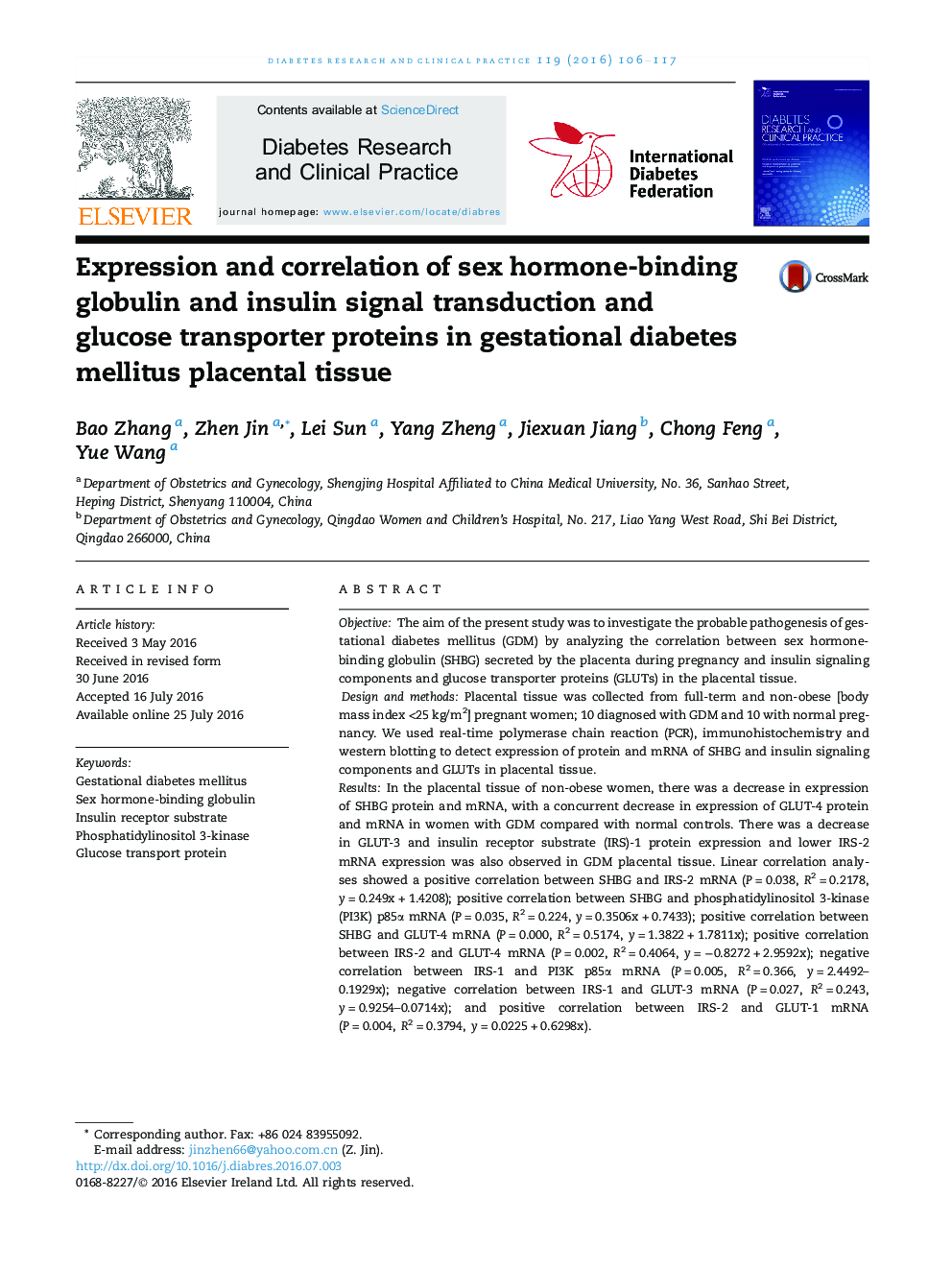| کد مقاله | کد نشریه | سال انتشار | مقاله انگلیسی | نسخه تمام متن |
|---|---|---|---|---|
| 5898890 | 1568796 | 2016 | 12 صفحه PDF | دانلود رایگان |
- This is the first study existing to analysis the correlation of SHBG and insulin signaling pathway and GLUT proteins in term placentae at both protein and mRNA levels.
- A remarkable positive correlation was found between insulin signaling components and SHBG.
- Our research significantly confirm that decreasing expression of SHBG may participate in the regulation insulin signaling, leading to a concomitant decrease expression of relevant insulin signaling components in placental tissue, implying insulin resistance and developing GDM finally.
ObjectiveThe aim of the present study was to investigate the probable pathogenesis of gestational diabetes mellitus (GDM) by analyzing the correlation between sex hormone-binding globulin (SHBG) secreted by the placenta during pregnancy and insulin signaling components and glucose transporter proteins (GLUTs) in the placental tissue.Design and methodsPlacental tissue was collected from full-term and non-obese [body mass index <25 kg/m2] pregnant women; 10 diagnosed with GDM and 10 with normal pregnancy. We used real-time polymerase chain reaction (PCR), immunohistochemistry and western blotting to detect expression of protein and mRNA of SHBG and insulin signaling components and GLUTs in placental tissue.ResultsIn the placental tissue of non-obese women, there was a decrease in expression of SHBG protein and mRNA, with a concurrent decrease in expression of GLUT-4 protein and mRNA in women with GDM compared with normal controls. There was a decrease in GLUT-3 and insulin receptor substrate (IRS)-1 protein expression and lower IRS-2 mRNA expression was also observed in GDM placental tissue. Linear correlation analyses showed a positive correlation between SHBG and IRS-2 mRNA (P = 0.038, R2 = 0.2178, y = 0.249x + 1.4208); positive correlation between SHBG and phosphatidylinositol 3-kinase (PI3K) p85α mRNA (P = 0.035, R2 = 0.224, y = 0.3506x + 0.7433); positive correlation between SHBG and GLUT-4 mRNA (P = 0.000, R2 = 0.5174, y = 1.3822 + 1.7811x); positive correlation between IRS-2 and GLUT-4 mRNA (P = 0.002, R2 = 0.4064, y = â0.8272 + 2.9592x); negative correlation between IRS-1 and PI3K p85α mRNA (P = 0.005, R2 = 0.366, y = 2.4492-0.1929x); negative correlation between IRS-1 and GLUT-3 mRNA (P = 0.027, R2 = 0.243, y = 0.9254-0.0714x); and positive correlation between IRS-2 and GLUT-1 mRNA (P = 0.004, R2 = 0.3794, y = 0.0225 + 0.6298x).ConclusionThe results confirm that defective receptors for insulin signal transduction and GLUT proteins are present in GDM placental tissue. Decreasing expression of SHBG may participate in regulation of insulin signaling, leading to a concomitant decrease in expression of relevant insulin signaling components in placental tissue, implying insulin resistance and eventual development of GDM.
Journal: Diabetes Research and Clinical Practice - Volume 119, September 2016, Pages 106-117
